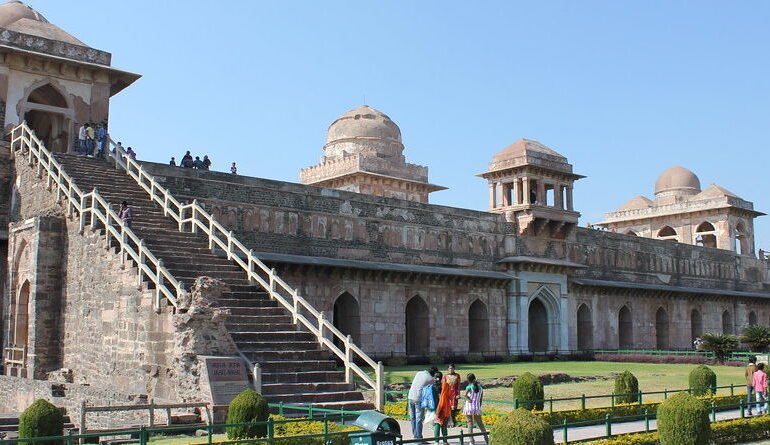Mandu, also known as Mandav or the “City of Joy,” is a historical treasure trove nestled in the heart of Madhya Pradesh. Famous for its magnificent forts, palaces, and architectural marvels, Mandu reflects the glory of a bygone era. This ancient city, perched on a plateau amidst the Vindhya Range, offers visitors a captivating blend of history, culture, and natural beauty. Whether you’re exploring the legendary Jahaz Mahal or gazing at the serene Rupmati Pavilion, Mandu promises a journey through time in a setting that is as enchanting as it is historic.
Mandu is located in the Dhar district of Madhya Pradesh, about 100 kilometers from Indore. This ancient city, with its rich history dating back to the 6th century, was once a flourishing kingdom and remains a testament to medieval Indian architecture and culture.
- Best Time to Visit: October to March, when the weather is pleasant and ideal for exploring the outdoor monuments.
- How to Reach: Mandu is well connected by road to major cities like Indore and Ujjain. The nearest airport is in Indore, about 100 kilometers away.
Cultural and Natural Highlights
Mandu is a city that resonates with tales of love, war, and architectural brilliance. Key attractions include:
- Jahaz Mahal: One of the most iconic structures in Mandu, the Jahaz Mahal, or “Ship Palace,” is a stunning two-story structure built between two lakes. The palace, with its reflection in the water, appears like a ship floating on the lake, hence its name. It’s a prime example of the architectural genius of the time.
- Rupmati Pavilion: This hilltop structure offers panoramic views of the surrounding countryside and the Narmada River valley. The pavilion is linked with the romantic tale of Rani Rupmati and Sultan Baz Bahadur, adding a touch of romance to the historic site.
- Hindola Mahal: Known as the “Swinging Palace” due to its sloping walls, Hindola Mahal is a unique architectural marvel in Mandu. It was used as a meeting hall and showcases the distinct style of the Malwa Sultanate.
- Baz Bahadur’s Palace: This palace, with its beautiful courtyards and large halls, was the residence of Baz Bahadur, the last independent ruler of Mandu. It reflects the blend of Rajasthani and Mughal architectural styles.
- Jami Masjid: Inspired by the great mosque of Damascus, the Jami Masjid in Mandu is an impressive structure with grand arches, domes, and a large courtyard. It’s a testament to the Islamic influence on the region’s architecture.
- Rewa Kund: This sacred water reservoir was built to supply water to Rani Rupmati’s palace. It is also a revered pilgrimage site for Hindus.
- Eco Point & Sunset Point: For nature lovers, Mandu offers several scenic spots like Eco Point and Sunset Point, where you can enjoy the lush greenery and stunning views of the surrounding landscape.
Food and Accommodation
Mandu offers a taste of local Malwa cuisine, with dishes like Dal Bafla (a traditional dish made with wheat dough balls served with dal and ghee), Poha, and Mawa Baati (a sweet delicacy). You can also find a variety of street food options around the main tourist areas.
Accommodation options in Mandu include heritage hotels, guesthouses, and resorts that offer a comfortable stay amidst historical surroundings. MPT Malwa Resort and Hotel Rupmati are popular choices for travelers looking for a cozy stay with easy access to major attractions.
Travel Tips
Explore Early: Start your day early to avoid the heat and have ample time to explore the historical sites.
Local Guides: Consider hiring a local guide to enrich your visit with fascinating stories and historical insights.
Photography: Don’t forget your camera! Mandu’s architecture and landscapes offer plenty of photo opportunities.
